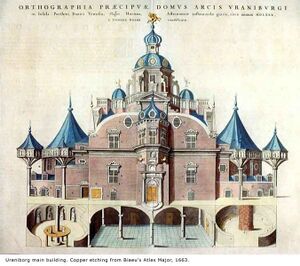Uraniborg (nonfiction)
Uraniborg (Danish: Uranienborg, Swedish: Uraniborg) was a Danish astronomical observatory and alchemy laboratory established and operated by Tycho Brahe. It was built c. 1576 – c. 1580 on Hven, an island in the Øresund between Zealand and Scania, which was part of Denmark at the time. It was expanded with the underground facility Stjerneborg on an adjacent site.
Brahe abandoned Uranienborg and Stjerneborg in 1597 after he fell out of favor with the Danish king; he left the country, and the institution was destroyed in 1601 after his death. Hven was later lost to Sweden, and the Rundetårn (Round Tower) in Copenhagen was inaugurated in 1642 as a replacement for Uraniborg's astronomical functions. Uraniborg's grounds are currently being restored.
History
The building was dedicated to Urania, the Muse of Astronomy, and it was named Uraniborg, "The Castle of Urania." It was the first custom-built observatory in modern Europe, though not the last to be built without a telescope as its primary instrument. The cornerstone was laid on August 8, 1576.
The main building of Uraniborg was square, about 15 meters on a side, and built mostly of red brick. Two semi-circular towers, one each on the north and south sides of the main building, gave the building a somewhat rectangular footprint overall. The plan and façade of the building, and also the plan of the surrounding gardens, are designed on grids, with proportions that Tycho carefully specified. These proportions may have been intended to make Uraniborg function as an astrological talisman, benefitting the health of its occupants by increasing the influences of the sun and Jupiter. The main floor consisted of four rooms, one of which was occupied by Brahe and his family, the other three for visiting astronomers. The northern tower housed the kitchens, and the southern a library. The second floor was divided into three rooms, two of equal size and one larger. The larger room was reserved for visiting royalty; James VI of Scotland (later James I of England) visited on March 20, 1590. On this level the towers housed the primary astronomical instruments, accessed from outside the building or from doors on this floor. Balconies, supported on wooden posts, housed additional instruments slightly further from the building, giving them a wider angle of view. On the third floor was a loft, subdivided into eight smaller rooms for students. Only the roofs of the towers reached this level, although a single additional tower extended above the loft in the middle of the building, similar to a widow's walk, accessed via a spiral staircase from the 3rd floor. Uraniborg also featured a large basement; it housed an alchemical laboratory at one end, and storage for food, salt and fuel at the other.
The observatory had a large mural quadrant affixed to a north-south wall, used to measure the altitude of stars as they passed the meridian. This, along with many other instruments of the observatory, was depicted and described in detail in Brahe's 1598 book Astronomiae instauratae mechanica.
A large wall, 75 meters on a side and 5.5 meters high, was planned to surround Uraniborg, but was never built; instead, a high earth mound was constructed. That mound has lasted until modern times, being the only remnant of the observatory still in place. Uraniborg was located in the very middle, with an extensive parterre garden between the mound walls and the building. In addition to being decorative, the gardens also supplied herbs for Brahe's medicinal chemistry experiments. The gardens are currently being re-created, using seeds found on-site or identified in Brahe's writings. At the gatehouses, Tycho incorporated his printing workshop and the island's prison.
Extending beyond the walls, Uraniborg's surrounding infrastructure included a system of aquaculture ponds, whose overflow powered a paper mill.
Uraniborg was an extremely expensive project. It is estimated that it cost about 1% of the entire state budget during construction.
Shortly after construction it became clear that the tower-mounted instruments were too easily moved by wind, and Brahe set about constructing a more suitable observation site. The result was Stjerneborg ("castle of the stars"), a smaller site built entirely at ground level and dedicated purely to observations (there was no "house"). The basic layout was similar to Uraniborg, with a wall of similar shape surrounding the site, although the enclosed area was much smaller. The instruments were all placed underground, covered by opening shutters or a rotating dome in buildings built over the instrument pits.
Upon losing financial support from the new king, Christian IV of Denmark, Brahe abandoned Hven in 1597 and both Uraniborg and Stjerneborg were destroyed shortly after Brahe's death.
Stjerneborg was the subject of archaeological excavations during the 1950s, resulting in the restoration of the observatory. Stjerneborg now houses a multimedia show.
In the News
Fiction cross-reference
Nonfiction cross-reference
External links:
- Uraniborg @ Wikipedia
